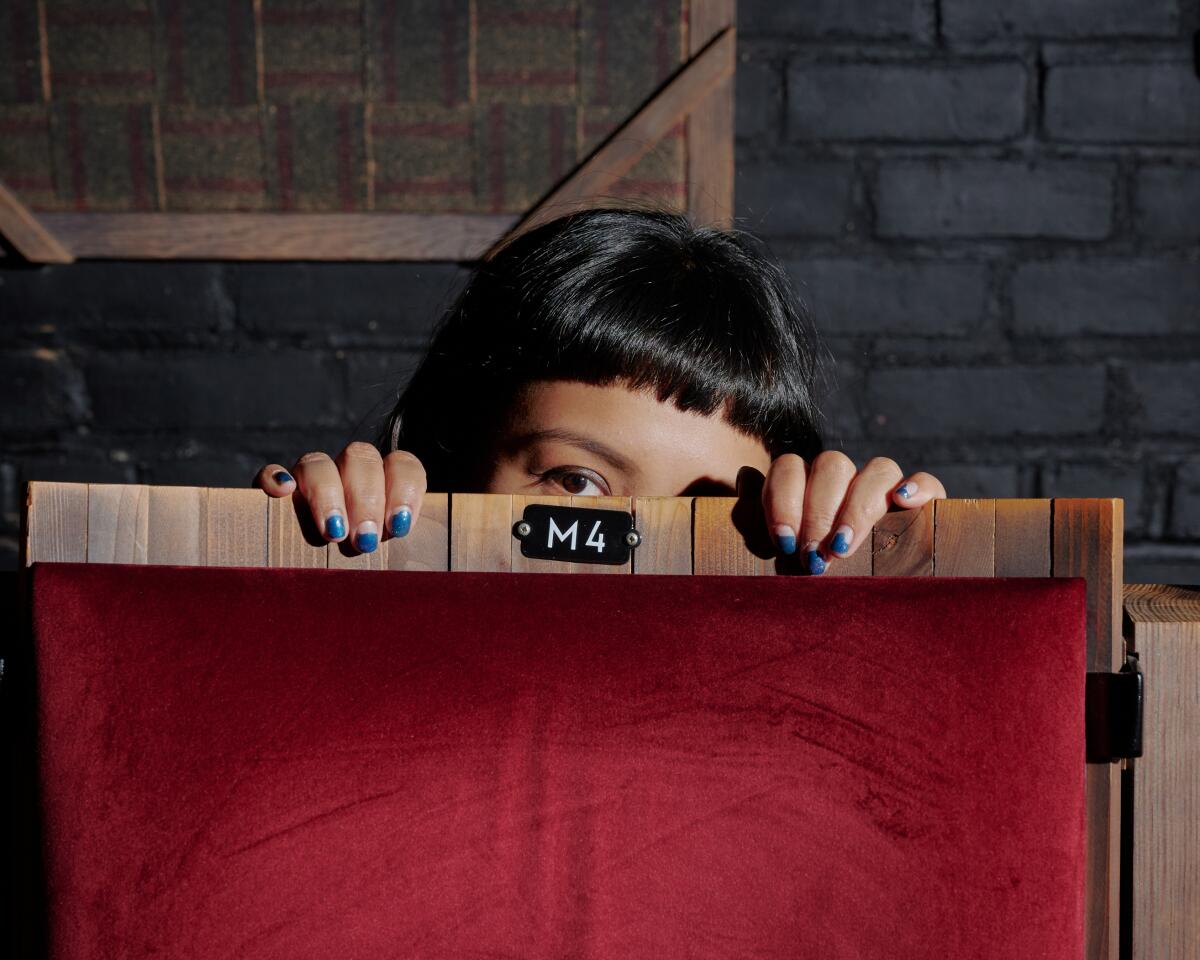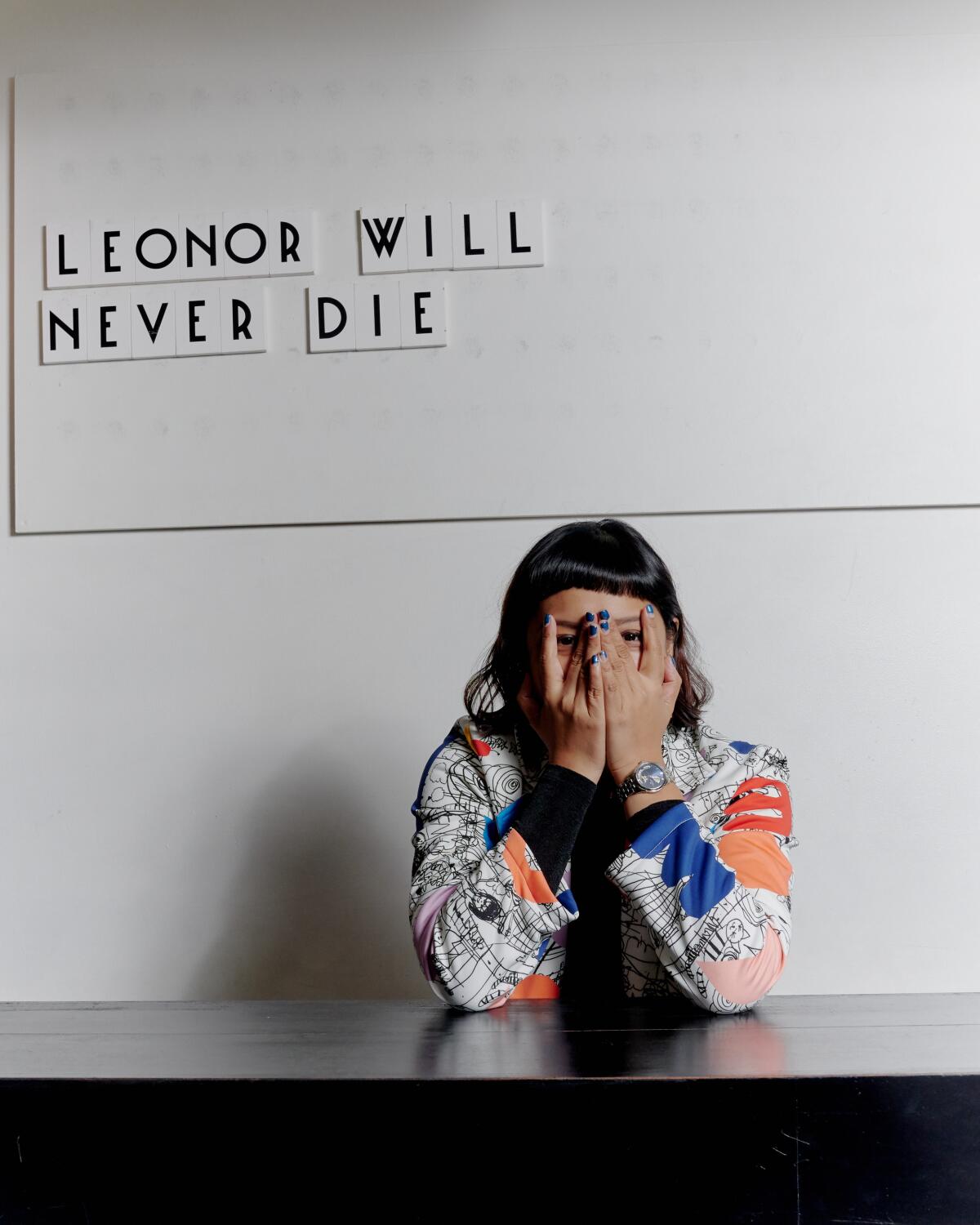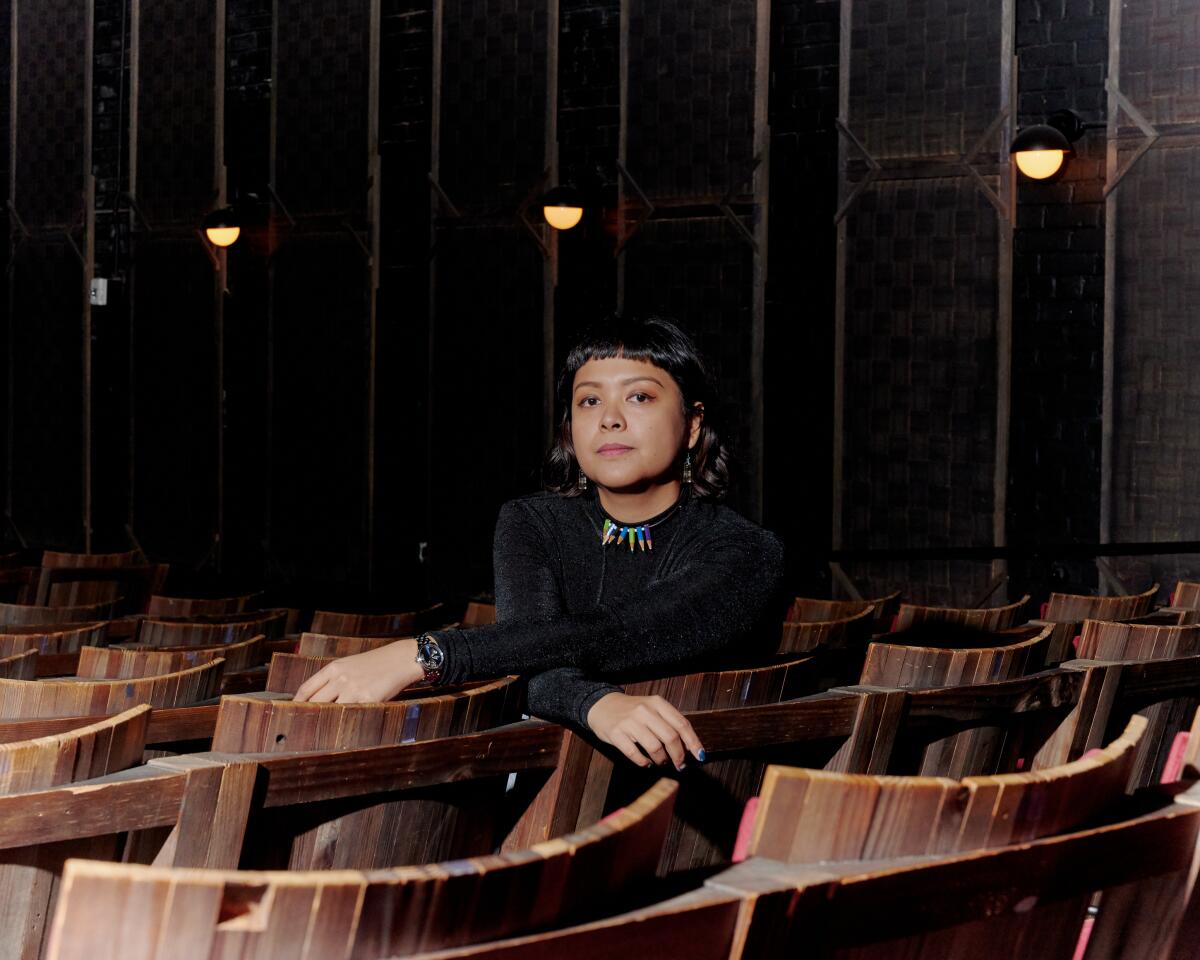Newsletter
Only good movies
Get the Indie Focus newsletter, Mark Olsen's weekly guide to the world of cinema.
You may occasionally receive promotional content from the Los Angeles Times.

A once-revered filmmaker weighed down by grief wakes up inside her own unfinished screenplay in “Leonor Will Never Die,” the audacious debut of Manila-based writer-director Martika Ramirez Escobar. Inspired by the macho Filipino action films of the ’70s and ’80s and her own beloved grandmother, she wondered: What would a lola do as an action hero, in a tale that blurred the line between fantasy and reality?
“I think life sucks,” Escobar, who started writing the film eight years ago and counts the late Agnès Varda among her inspirations, said with a soft smile over video from New York. “And every time I see my grandma, she tends to redeem my disappointment in life. I think that’s mainly the reason why I decided to have a grandma action star. She seems to find so much beauty in this sick, sad world, and I’d like to attain that wisdom someday.”
Stage veteran Sheila Francisco stars in her first lead film role as Leonor Reyes, whose successful career making popular action yarns stalled years ago with the tragic death of her favorite son. When a falling TV set knocks her unconscious, she is transported into the world of her most personal movie yet as Escobar’s bold blend of action, fantasy and family melodrama unfolds into a meta exploration of what cinema means to those who make it. Bong Cabrera, Rocky Salumbides and Anthony Falcon also star.

A lifelong image-maker who as a child documented everything around her with the family camcorder, Escobar, 30, also drew from the stranger-than-fiction rise of movie star politicians in her country, such as ousted Philippines President Joseph Estrada, who was elected to office when she was 6, and 2004 presidential nominee Fernando Poe Jr. “I think it reflects our fascination with these action heroes,” said Escobar. “But I never saw a woman in it.”
The phenomenon isn’t limited to the Philippines, of course; Arnold Schwarzenegger is a prime example of fiction bleeding into American politics that has come up frequently as Escobar has traveled the world with “Leonor Will Never Die,” given its similarities to the former Governator’s 1993 meta picture “Last Action Hero.” (The comparison has her curious, but she hasn’t seen the film.)
Writer-director Martika Ramirez Escobar’s debut feature ‘Leonor Will Never Die’ celebrates the universal ridiculousness of 1970s and ‘80s exploitation films.
Instead, she had a lifetime of obsession to inspire her. “I’m interested in making meta films because as a person, I imagine life as one really long film,” said Escobar, who used her life savings (and sold her car) to help get “Leonor” made with the help of independent financiers. The sacrifices paid off earlier this year when the film premiered at the Sundance Film Festival — only the second film from the Philippines to screen in the world cinema dramatic competition in nearly two decades — where it took home a special jury prize for innovative spirit.
Now the film, in select theaters, is nominated for an Independent Spirit Award for best international film. Escobar dove into her “Leonor” inspirations, artistic interrogations and how the years-long process of making her debut feature is leading her to ask new questions as a filmmaker.

The idea of being pulled beyond the veil into a film is particularly magical for cinephiles. What were some of the movies that informed you as you wrote “Leonor”?
I don’t have a specific list, but I always say it’s the films of Agnès Varda. Locally, it’s Kidlat Tahimik and his film “Perfumed Nightmare.” And I like the films of Spike Jonze and Michel Gondry. I think they’re reflective of the do-it-yourself spirit of “Leonor.”
I wrote it for four years, so my influences kept changing. In the beginning, I was into music videos, all the surreal Gondry films. Midway, I was interested in the French New Wave filmmakers, in playing with form, which also reflects in the middle of the film. “Mulholland Drive” is also a key film in inspiring “Leonor,” and also “By the Time It Gets Dark” by Anocha Suwichakornpong, from Thailand. Her film is a film within a film within a film — it’s like one big dream.
What intrigued you about placing a character like Leonor at the center of an action film?
I was interested in the idea of having a woman in a macho genre trying to solve the problems of society, not through violence but through peaceful ways — through communication, through treating people as humans, seeing the goodness in them. It’s a perspective on life that I wanted to have in these action films.
How much does Leonor resemble your own grandmother?
I didn’t use Leonor as a direct figure of my grandma. My grandmother doesn’t know it, but she’s a cinephile. In the Philippines, senior citizens can watch movies in the cinema for free on Mondays and Tuesdays. So for more than one decade, she and my grandpa would watch all the films playing in the cinemas all year. I don’t even know half of the films they’ve seen. I think it also stems more from their ... not obsession, but fascination with watching and being in a cinema. So my grandma is similar to Leonor in many ways, but not in the way that Leonor is a sad recluse.
Many scenes in the film are based on real life, from the electricity [bill going unpaid] to having a son who passed away. I think, like Leonor, my grandma doesn’t like talking about these things. She’d rather make noise to not hear the things she doesn’t want to hear. I think she liked [the film]. She saw that I was obsessed with making it for the past half-decade, and she was happy it finally was released [to] the world.
My grandmother doesn’t know it, but she’s a cinephile.
— Martika Ramirez Escobar
Leonor winds up in one of her own unfinished screenplays, but it’s only within this world of her own creation that she is able to process her most difficult emotions. Your short films also feature protagonists who work in or with film. Why this is such a rich entry point for you?
I’m interested in making meta films because as a person, I imagine life as one really long film. We keep writing and revising; it has different genres and different characters; it has an editor, which I can’t control. But it’s also, I think, because filmmaking has been so precious to me. It’s the only thing I know how to do. Ever since I was young, I was interested in using the camera. I like the idea of being able to capture precious moments and being able to replay it, to cut it, to show it to people.
I see making films as an extension of life and an extension of ourselves. You get to learn so much about people and life and their complexities. I even care more about the process than the work itself, and that’s why I really like “Leonor” — because it grew into something that I didn’t expect, that I didn’t plan, from the first script I wrote eight years ago.
What’s one way in which “Leonor” became something unexpected along the way?
Initially, I wanted to make a film about a person who gets transported into her work. But I realized after making “Leonor” that what we were making was actually a life form. Like a human, it keeps on growing. I realized that the film continues to grow in every screening we have. And it’s that growth of the film that I didn’t really expect.
I thought, “OK, I wrote the script, we’d shoot it, it’s done, export it, premiere, and then it’s over.” And apparently that’s just the beginning. We didn’t even think we would get into Sundance or have a premiere that big. When we were making it, our dream was to screen in a small cinema with more than 10 people.

It’s been an eight-year journey getting “Leonor” made and seen. How did you finance it, and what sort of responses did you get initially to such a high-concept project?
We pitched to all major studios slash companies in the Philippines. Even abroad I applied for many. But we never found the partners we needed. Even today, we still don’t have the right ones. We made it for a small budget from the support various private investors gave us. Some were art patrons, and some were friends. I sold my car and [used] my life savings. My producers agreed that all of us, me and my producers, will not get paid until the film earns. So it’s really difficult in that sense. Because even on paper, you already know it’s a project that won’t get its money back.
Even now, we still don’t have our money back. We do have festivals, we have screenings, we got recognized somehow, and we’re happy for that. But it’s a film that’s difficult to make, and I think it’s an achievement to just make it with our little resources, because it meant that you really wanted to make it, even if we have nothing. It’s made with a lot of heart, and I think that’s what people connect to when they see it. It’s like a giant student film.
How did you conceive the look and texture of the action film within the film, replicating hallmarks of ’70s and ’80s action cinema, and convey those textures to your crew?
It started off by playing off memories. Since we’re so familiar with watching these action-film replays, one can easily recall how it looks like and how it sounds like, what the lights are, where the locations are, how they act and move. We had to look at the nuances of these films. For example, in the action world, it’s not just an action film shot on film and then placed into the film. It’s an action film shot on film, transferred to VHS, played on TV, damaged for years and then seen in the cinema. We had to think of those layers, focus on the nuances, and they had a set of rules.
I tend to be really specific, so I did the settings myself. I balanced the amount of grain and damage. My cinematographer and sound designer and production designer, we’d often have one-on-one meetings, and those meetings lasted for hours. And we had time to actually do this. On a usual film, we don’t have time. But for “Leonor,” one of the things we’re lucky to have was several years to think about these small things.

Did you and your crew share the same cultural memories of the action movies of the era you were referencing?
We’re all around the same age, our key staff, or close to it. So we are familiar with the same things. We can recall the bad zooms, the bad dolly shots, the multiple cameras and the stunts. It was easy for us to imagine the world we were trying to create. We were aligned with that. We didn’t even watch films together. It’s more like we just trusted that they knew what they were doing.
But I gave them a few titles. So many action films from that era are available on YouTube in their full form, so it’s easy to study by taking screencaps and observing what are the details, what makes this feel like it’s from the ’70s or from the ’80s? What makes it sound like that?
Which of these movies did you reference?
Type in on YouTube “FPJ” [Fernando Poe Jr.]. They will all appear, and some of them are even restored. That’s the strange part. I don’t know who uploads these films! They have so many views. And it says a lot about how these films are still seen until this day. [Poe Jr.] can’t die onscreen, because the one time he died, people didn’t like it.
Have you begun work on your next projects?
I’m constantly writing and thinking of ideas, even if I don’t have to. That’s how I operate. I like to make films out of everything. For the next project, I will pick up from where I left off from “Leonor.” “Leonor” started as a very rigid film. I had storyboards, picture boards, video shot lists. I was very strict in how I wanted things. In the latter parts of shooting “Leonor,” I decided to let go of it, because I realized that allowing it to form itself made it more real — it gave it more life.
For the next film, I want to embrace spontaneous filmmaking with a smaller team, a smaller budget, but longer shoot days and also more freedom. I had absolute freedom in “Leonor,” but I think there can be more.

Only good movies
Get the Indie Focus newsletter, Mark Olsen's weekly guide to the world of cinema.
You may occasionally receive promotional content from the Los Angeles Times.